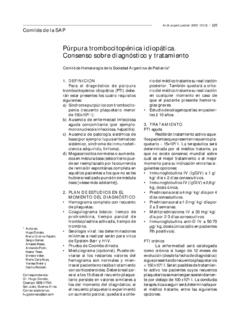Transcription of Material and Methods - ITP Foundation
1 1 Predisposing and modulating genetic factors in idiopathic thrombocytopenic purpura (ITP) Johannes Rischewski*, Karl Heinimann , Thomas K hne*. *Pediatric Hematology and Oncology and Medical Genetics, University Children's Hospital Basel (UKBB), Switzerland CONTENTS page 2 General part: Synopsis (Introduction, Hypothesis, Methods , Proposal, Conclusion and Vision) 3 Scientific part: Introduction Hypothesis Rationale 4 Objectives Aims Material and Methods 5 Interim report and proposed modifications 2 Predisposing and modulating genetic factors in idiopathic thrombocytopenic purpura (ITP) Johannes Rischewski*, Karl Heinimann , Thomas K hne*. *Pediatric Hematology and Oncology and Medical Genetics, University Children's Hospital Basel (UKBB), Switzerland Synopsis Introduction: Control of bleeding depends on an adequate number of blood platelets (thrombocytes). Any reduction in the number of platelets (thrombocytopenia) can lead to a bleeding tendency.
2 If the bleeding occurs into the skin, it leads to a deep-red color, called purpura . In idiopathic - thrombocytopenic purpura (ITP) an immune mediated mechanism leads to an elimination of blood platelets from the circulation. Antibodies, that normally help eliminating foreign materials such as potentially dangerous invaders of the body, bind to platelet surface receptors. Subsequently they get destroyed by other cells. Cells of the immune system are normally able to distinguish between self and foreign structures. Cells with potential autoreactivity ( with the potential to destroy self-structures) are usually inactivated. Thus, autoreactivity reflects a dysbalanced immune system, which is termed autoimmune disease. Genes encoding structures involved in the destruction of autoreactive cells ( apoptosis ) could be involved in the genesis of ITP. Apoptosis consists of a complex machinery of the body in order to destroy cells which are no longer needed.
3 Within the immune system, the mechanism is needed to destroy potentially autoaggressive effector cells. In ITP, defective apoptosis mechanisms could hence allow for the survival of autoreactive effector cell populations resulting in the destruction of thrombocytes. A preliminary analysis of registry data of ITP patients and of patients in our hospital has detected a surprisingly high number of patients with suspected ITP with affected family members, suggesting genetic risk factors. Hypothesis: Genetic risk factors predispose to and influence the clinical course of ITP. Analysis of familial ITP cases focussing on apopotic pathways might reveal involved genes. Methods : DNA from a blood sample will be used to analyze target genes by molecular genetic techniques. Results will be compared with healthy controls. Unknown genes involved in diseases can be searched by using known sequence variations, called single nucleotide polymorphism s ( SNP ).
4 If SNP's show a different distribution in in affected and healthy individuals, genes near to the SNP's can be analyzed for a possible role in ITP. Proposal: A study on the potential involvement of genes in ITP. Evaluation of apoptosis-genes, followed by a genome wide search for yet unknown genes involved in the pathogenesis of ITP. Conclusion and vision: We aim for a better understanding of ITP in children. ITP can be seen as a model for autoimmune disorders. Understanding underlying causes could allow to develop more targeted therapies with less side effects than the used drugs, and could help to identify patients with an increased risk for bleeding complications. 3 Introduction: idiopathic or immune- thrombocytopenic purpura (ITP) is defined as a bleeding disorder of children and adults with the hallmark of autoimmune mediated thrombocytopenia. ITP is still a diagnosis of exclusion. The term ITP is likely to define a group of etiologically diverse diseases with an heterogeneous and complex genetic background.
5 Etiological and pathophysiological uncertainties about ITP and a significant lack of data concerning the optimal clinical management in 1997 lead to the Foundation of the Intercontinental Childhood ITP Study Group (ICIS). ICIS ( ) provides a worldwide network for clinicians involved in research and clinical management of ITP patients. The Pediatric and Adult Registry on Chronic ITP (PARC-ITP) ( ) was started by ICIS in 2004. PARC-ITP collects data on adult and pediatric patients enabling subsequent research projects. Goals are analyses of the heterogeneity in ITP, of the etiopathology of the disease, and of the value of diagnostic Methods and criteria. The data collection is coordinated by the ICIS office in Basel. The study of genetic aspects of ITP as a model for autoimmune disorders is the first substudy of PARC-ITP. The goal is to identify genetic loci which potentially predispose to ITP, or that could influence the course of the disease.
6 Within the international cooperation and the University Children's Hospital Basel (UKBB) the collection of a case-control cohort for genetic analyses is in progress. The Basel ethics committee has approved the proposed study. We propose a molecular genetic study on the genetic background of ITP, which allows us to start the analysis of the genetic background in a defined area, apoptosis. Prevalence of mutations and polymorphism's in the FAS-receptor (TNFRSF6, CD95) gene in patients with ITP and a positive family history Hypothesis FAS receptor gene mutations are more common in patients with acute or chronic ITP with a positive family history for auto-immune disorders or lymphoproliferative disorders than in the normal population. FAS receptor mutations can be associated with a chronic course of ITP. Rationale ALPS (autoimmune lymphoproliferative syndrome, OMIM 601859) was first described in 1967 by Canale and Smith as a syndrome in childhood, defined by lymphadenopathy, splenomegaly and autoimmune-cytopenia.
7 According to the underlying genetic defects three groups can be differentiated: ALPS1A with mutations in the FAS-receptor gene, ALPS1B with mutations in the FAS-ligand gene, ALPS2A and 2B with mutations in the caspase 8 and 10 genes, and ALPS3 with unknown gene defects, possibly representing patients with somatic mosaicism, carrying heterozygous FAS-gene mutations in the double negative T-cell fraction only (Holzelova E et al, 2004)i. Autoimmune cytopenia is common in ALPS patients (Straus SE et al, 1999)ii. In a study with nine ALPS patients, 1/9 had an ITP, 2/9 an Evans syndrome (hemolytic anemia and ITP), and 6/9 hemolytic anemia. Eight of nine patients carried FAS-gene mutations, and heterozygous carriers without manifestation of the disease showed in vitro abnormalities 4 of the FAS-mediated apoptosis (Snellere al, 1997)iii. Recently it was shown that 7/12 patients with Evans syndrome had an increased number of double negative T-cells as well as a deficient FAS-mediated apoptosis (Teachey DT et al, 2005)iv.
8 The importance of this study lies in the indication, that ALPS is likely to be much more common than expected. Only very few ITP-patients have been studied for FAS-gene mediated apoptotic defects (Dianzani U et al, 1997)v. In two patients with ITP a defective FAS mediated apoptosis without lymphoproliferation was found. Both patients had normal double negative T-cell numbers (Shenoy S et al,2001)vi. Considering the available data, it is possible, that in cases of ITP with positive family history either with or without fulfilling the diagnostic criteria of ALPS or Evans-Syndrome, an increased incidence of FAS-receptor mutations can be present. Objectives of the study The study will try to answer the following questions: a) Can FAS-receptor gene mutations be detected in patients with ITP and positive family history? b) Are double negative T-cells (T-cell receptor alpha-beta+CD3+CD4-CD8-) in these patients detectable, as in ALPS patients?
9 C) Can other genetic abnormalities be identified in addition to FAS receptor mutations? Aims of the study The definition of underlying genetic disorders may help to diagnose ITP, and could allow for targeted therapies. For ALPS patients, new substances are under phase 1 clinical tests (pyrimethamine and sulfadoxin), which have the potential of altering the clinical course of the disease (van der Werff Ten Bosch J et al, 2002)vii. If FAS-receptor gene mutations are involved in the genesis of ITP, these new immune-modulating strategies could also be evaluated for ITP. If additional genes of interest can be identified, further molecular genetic studies are warranted. Material and Methods 1) Collection of EDTA blood samples from ITP patients and all available family members, if a further member of the family suffers an autoimmune or lymphoproliferative disease. 2) Mutation analysis of the FAS receptor gene (9 exon's, 1007bp coding sequence) by direct DNA sequencing of genomic DNA.
10 Restriction digest analysis of the FAS promotor polymorphism >A and of the polymorphism >T. 3) Flow cytometric analysis of CD3+CD4-CD8- cells of all affected family members. 4) SNP based genome wide analysis of the collected families. Estimation of LOD scores within the families, estimation of H-LOD scores after analysis of several families, which show evidence of the same mode of genetic transmission. Search of putative genes of interest within the defined genomic regions using the HUGO genebank. Direct sequencing of genes of interest, if identified. 5 Interim report and proposed modifications of the initial project: a) Sample acquisition: A total 30 pediatric ITP samples could be collected in the Argentinian cohort. A total of 8 pediatric and 25 adult ITP samples could be collected in the Korean cohort. A total of 83 pediatric samples could be collected in the Basel cohort, of those 32 are ITP index cases, of those 6 are ITP cases with a positive family history.





